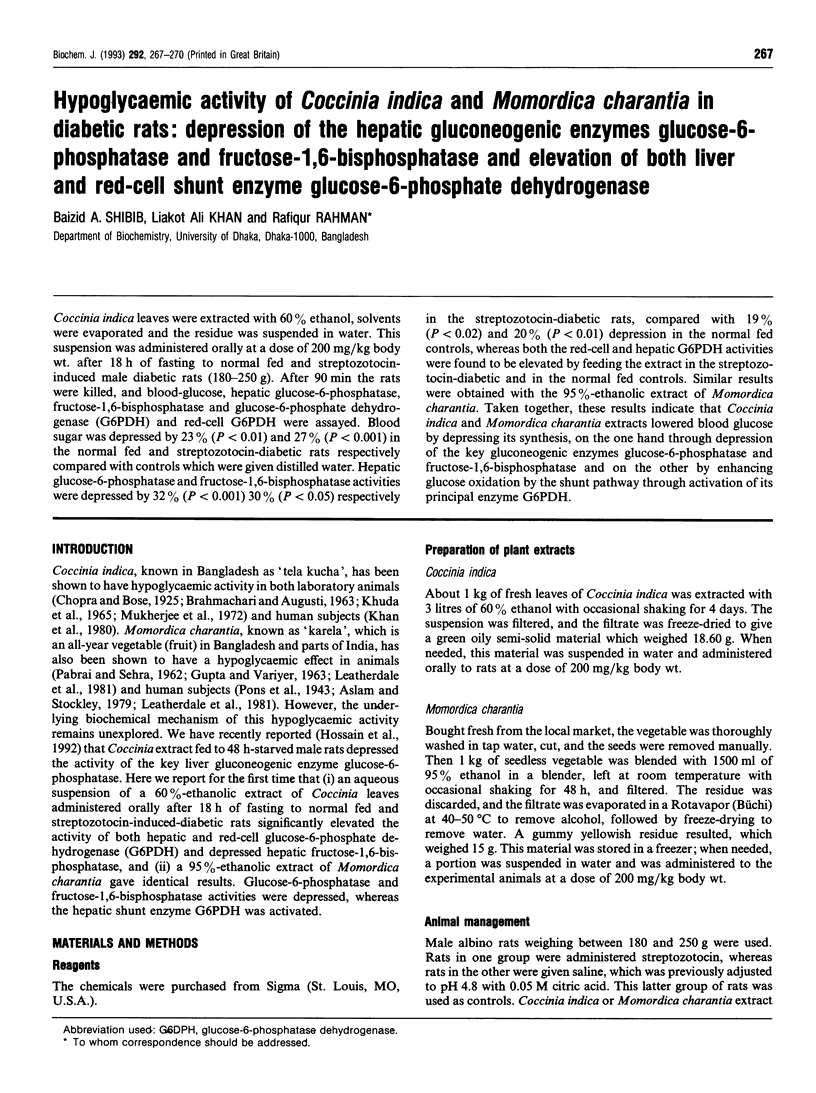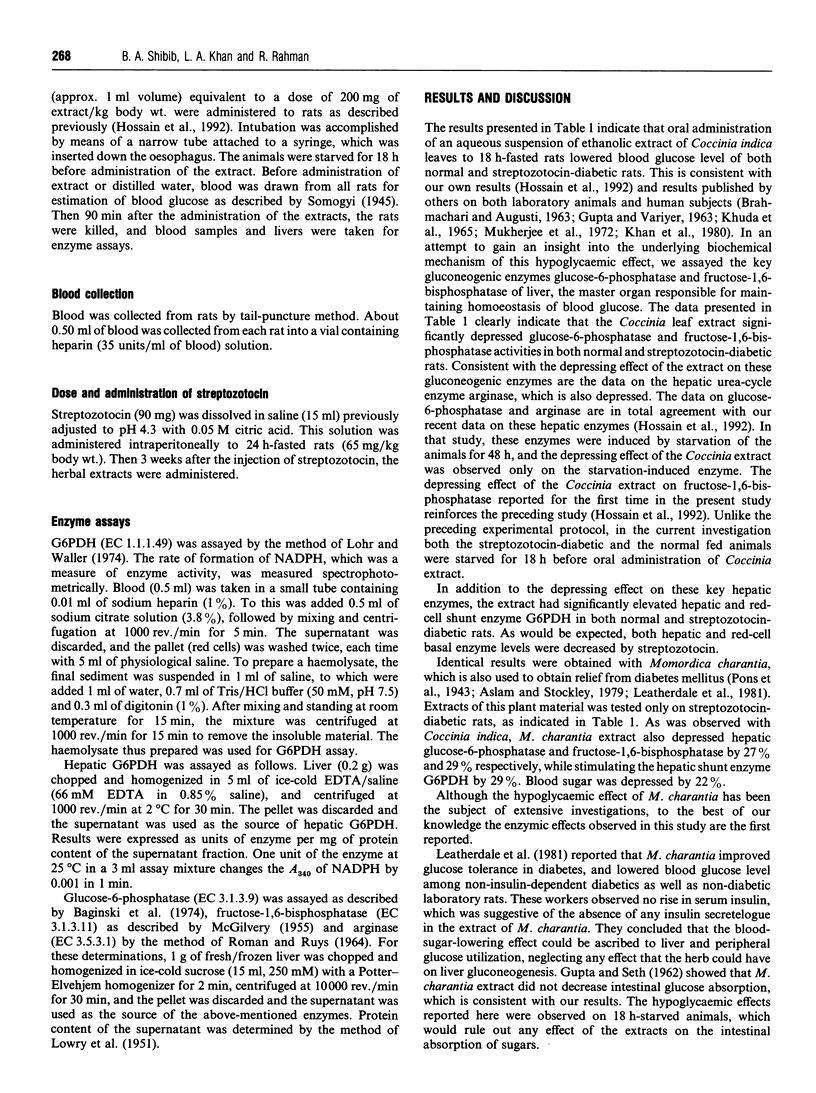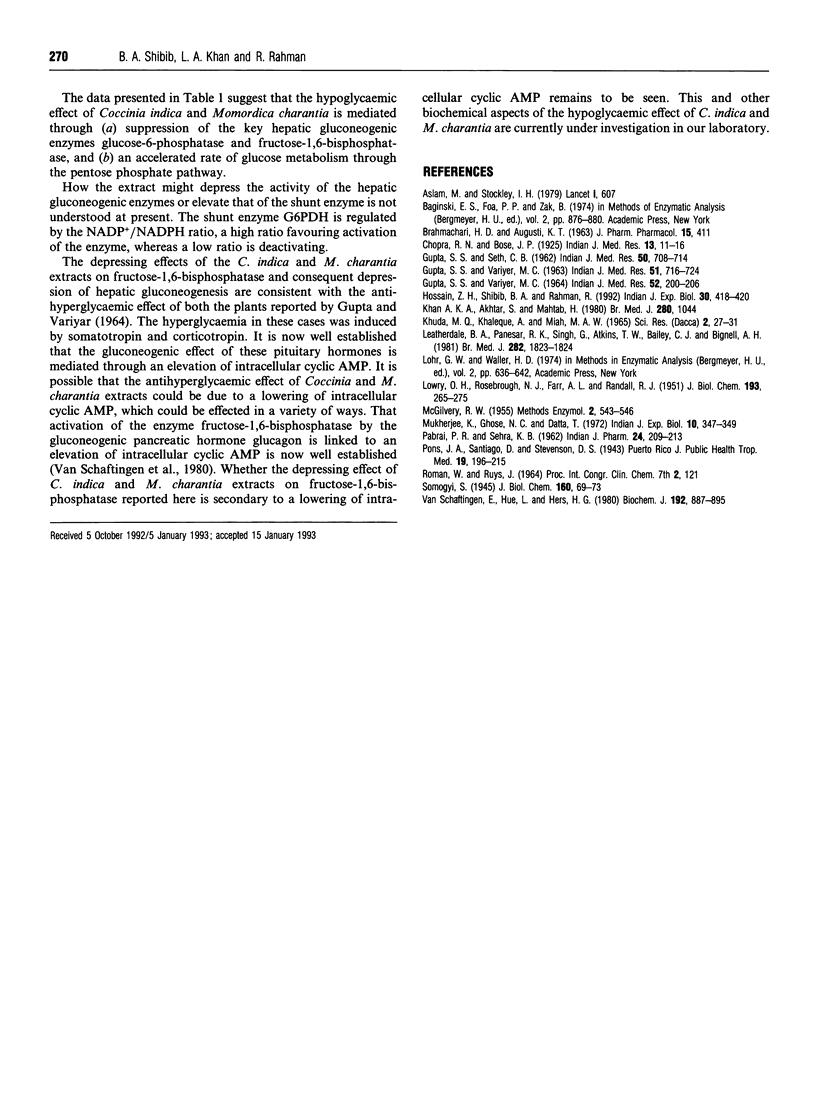Abstract
Coccinia indica leaves were extracted with 60% ethanol, solvents were evaporated and the residue was suspended in water. This suspension was administered orally at a dose of 200 mg/kg body wt. after 18 h of fasting to normal fed and streptozotocin-induced male diabetic rats (180-250 g). After 90 min the rats were killed, and blood-glucose, hepatic glucose-6-phosphatase, fructose-1,6-bisphosphatase and glucose-6-phosphate dehydrogenase (G6PDH) and red-cell G6PDH were assayed. Blood sugar was depressed by 23% (P < 0.01) and 27% (P < 0.001) in the normal fed and streptozotocin-diabetic rats respectively compared with controls which were given distilled water. Hepatic glucose-6-phosphatase and fructose-1,6-bisphosphatase activities were depressed by 32% (P < 0.001) 30% (P < 0.05) respectively in the streptozotocin-diabetic rats, compared with 19% (P < 0.02) and 20% (P < 0.01) depression in the normal fed controls, whereas both the red-cell and hepatic G6PDH activities were found to be elevated by feeding the extract in the streptozotocin-diabetic and in the normal fed controls. Similar results were obtained with the 95%-ethanolic extract of Momordica charantia. Taken together, these results indicate that Coccinia indica and Momordica charantia extracts lowered blood glucose by depressing its synthesis, on the one hand through depression of the key gluconeogenic enzymes glucose-6-phosphatase and fructose-1,6-bisphosphatase and on the other by enhancing glucose oxidation by the shunt pathway through activation of its principal enzyme G6PDH.
Full text
PDF



Selected References
These references are in PubMed. This may not be the complete list of references from this article.
- Aslam M., Stockley I. H. Interaction between curry ingredient (karela) and drug (chlorpropamide) Lancet. 1979 Mar 17;1(8116):607–607. doi: 10.1016/s0140-6736(79)91028-6. [DOI] [PubMed] [Google Scholar]
- BRAHMACHARI H. D., AUGUSTI K. T. Orally effective hypoglyceamic principles from Coccinta indica Wight and Arn. J Pharm Pharmacol. 1963 Jun;15:411–412. doi: 10.1111/j.2042-7158.1963.tb12807.x. [DOI] [PubMed] [Google Scholar]
- GUPTA S. S. EXPERIMENTAL STUDIES ON PITUITARY DIABETES. III. EFFECT OF INDIGENOUS ANTI-DIABETIC DRUGS AGAINST THE ACUTE HYPERGLYCAEMIC RESPONSE OF ANTERIOR PITUITARY EXTRACT IN GLUCOSE FED ALBINO RATS. Indian J Med Res. 1963 Jul;51:716–724. [PubMed] [Google Scholar]
- GUPTA S. S., SETH C. B. Experimental studies on pituitary diabetes. II. Comparison of blood sugar level in normal and anterior pituitary extract-induced hyperglycaemic rats treated with a few Ayurvedic remedies. Indian J Med Res. 1962 Sep;50:708–714. [PubMed] [Google Scholar]
- GUPTA S. S., VARIYAR M. C. EXPERIMENTAL STUDIES ON PITUITARY DIABETES. IV. EFFECT OF GYMNEMA SYLVESTRE AND COCCINIA INDICA AGAINST THE HYPERGLYCAEMIC RESPONSE OF SOMATOTROPIN AND CORTICOTROPIN HORMONES. Indian J Med Res. 1964 Feb;52:200–207. [PubMed] [Google Scholar]
- Hossain M. Z., Shibib B. A., Rahman R. Hypoglycemic effects of Coccinia indica: inhibition of key gluconeogenic enzyme, glucose-6-phosphatase. Indian J Exp Biol. 1992 May;30(5):418–420. [PubMed] [Google Scholar]
- Khan A. K., AKhtar S., Mahtab H. Treatment of diabetes mellitus with Coccinia indica. Br Med J. 1980 Apr 12;280(6220):1044–1044. doi: 10.1136/bmj.280.6220.1044. [DOI] [PMC free article] [PubMed] [Google Scholar]
- LOWRY O. H., ROSEBROUGH N. J., FARR A. L., RANDALL R. J. Protein measurement with the Folin phenol reagent. J Biol Chem. 1951 Nov;193(1):265–275. [PubMed] [Google Scholar]
- Leatherdale B. A., Panesar R. K., Singh G., Atkins T. W., Bailey C. J., Bignell A. H. Improvement in glucose tolerance due to Momordica charantia (karela). Br Med J (Clin Res Ed) 1981 Jun 6;282(6279):1823–1824. doi: 10.1136/bmj.282.6279.1823. [DOI] [PMC free article] [PubMed] [Google Scholar]
- Mukherjee K., Ghosh N. C., Datta T. Coccinia indica Linn. as potential hypoglycaemic agent. Indian J Exp Biol. 1972 Sep;10(5):347–349. [PubMed] [Google Scholar]
- Van Schaftingen E., Hue L., Hers H. G. Control of the fructose-6-phosphate/fructose 1,6-bisphosphate cycle in isolated hepatocytes by glucose and glucagon. Role of a low-molecular-weight stimulator of phosphofructokinase. Biochem J. 1980 Dec 15;192(3):887–895. doi: 10.1042/bj1920887. [DOI] [PMC free article] [PubMed] [Google Scholar]


